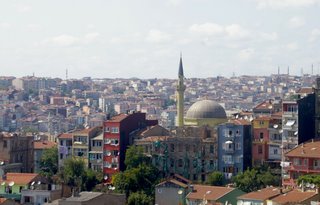
CITY OF LAYERS
Like several times in its past, Istanbul has exploded in population and income to become a truly global city. Today the population stands at around 11 million, one of the largest cities in Europe or Asia, and is Turkey’s foremost economic domain. Agricultural policies in the post war era, as well as a long simmering war with the Kurdish population has led to a dramatic immigration from the rural lands. The quirky Turkish law that allows any structure built overnight to remain led to a black market economy of gecekondu, literally overnight housing, for this migrant population. As much as 60% of the city may have originally been built this way. This newly relocated and underemployed population provides for the highly energetic service economy. Even small cafes and shops have half a dozen staff catering to you. This remarkable level of service both enhances and defines the tourist experience; the competition to hook a sale leads to the gauntlet of “hey mister” cries that can tire out even the sturdiest of visitors.

Its location between Europe and Asia makes Istanbul an intriguing destination for each continent to get an accessible taste of the other. Flights from both Frankfurt and Cairo routinely run $100 and take only 2 hours. Its proximity and allure to different cultural spheres has made it one of Europe and Asia’s fastest growing tourist destinations. However, this liminal position means that it is also subject to greater vicissitudes of visitors during good and bad times. This year tourism from the west is down due to the combined news of the bird flu, renewed terrorism by the Kurdish PKK, and war in the Middle East. Tourism from the east remains strong and likely will continue to grow with the recent reawakening of Islamic pride in Turkey; seeing the Sultan Ahmet Mosque during Friday prayer is an awesome sight because of the numbers of religious tourists in collective prayer.
In addition to being a gateway to the “other,” Istanbul is also claimed by multiple cultures; depending on whom you ask, Constantinople either “fell” or was “conquered” in 1453. Greeks, Romans, Christians, Moslems, Turks, Hittites, and Mongols have in time ruled. This piling on of conquest has resulted in a city uniquely endowed with cultural heritage. As a world center of commerce and empire for 2500 years, Istanbul simply cannot dig without unearthing its past: this year, when excavating for a railway tunnel under the Bosporus, construction workers discovered a rare intact 4th century port. It is true that relics continue to disappear at an alarming rate, but it is difficult to persuade the general public of the danger. The city is the equivalent of a rain forest of antiquities.

The extent of the tourist city is neatly indicated by the Plan Tours bus route. For only €20 one can get a grip on the city in 58 bite sized chunks. Not included on the tour is the new middle class city. Skyscrapers are kept at a healthy distance from the old city after some unfortunate examples were built in nearby Beşiktaş and Taksim; the wildly popular Kanyon Mall in Levent by Jerde Partnership, connected by a quiet and clean metro has security check-in; Kemer Country, designed in part by Andreas Duany, is a suburb that blends Ottoman stylings on an American suburban superstructure:
"These are modern homes, each one carefully designed to blend in not only with their lovingly landscaped setting but with a tradition of architecture and the inspiration of the great Turkish architect Mimar Sinan, whose awesome aqueducts rise up in the distance. This is Istanbul? As seen from Kemer Country." (From KemerCountry.com)

Kanyon Mall by Jerde Partnership
The old city is kept free of these new symbols of growth, and in fact might be regressing to an earlier form as the city government pushes forward with plans to rebuild several streets in their best approximation of the Ottoman style. This is clearly the acceptable historic era, exhibiting the once great Turkish empire while also satisfying the contemporary traveling public’s desire for a sensory experience with the past. What better way to really see Istanbul/Constantinople than to wander the “same” streets that beguiled Pierre Loti? After all, when you’ve come this far, you don’t want to see concrete government buildings. This is the heart of cultural tourism: not to see the re-creations (we go to Miniatürk for that), but to be among the aura of the original. Thus, the skyscrapers and growing middle class of new Turkey are banished to the outskirts like the North African banlieus of Paris. They are neither seen nor heard and the old city can go back to being its timeless self.

This study will focus on two remnants of the fallen city, artifacts that once demonstrated greatness, but now get in the way. As such they have been pulled into the fabric of the city by both municipal projects and individuals. First, the old city walls, as in so many contemporary cities, are obsolete. They are also ugly; while many remark on their impressive scale, few will wax on their aesthetic value. Because of their original use of providing safety, they are at odds with contemporary needs for free flowing communication. This combination makes them an interesting tool with which to read the growth of the city. Second, the former Hippodrome is today conspicuously absent from the scene. It is often remarked upon in tourist guides and occupies an almost mythical role in the history of the city, but is represented by three decaying monuments and a strangely anonymous 40 meter wall.
Next stop: Harbor Walls